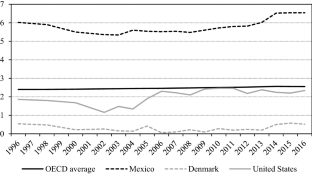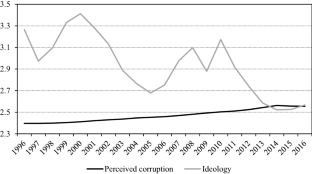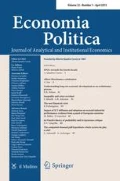Abstract
This paper studies the relationship between government ideology and the level of perceived corruption, using a panel data of OECD countries covering the years 1996–2015, and the effect that the Great Recession has exerted on that relationship. We find that, before the onset of the Great Recession, governments formed by one (or more) right-wing parties are perceived as being around 1% more corrupt than those formed by one (or more) left-wing parties. We also find that misuse of public funds under coalitional governments is more likely to be perceived, that the longer the party of the current chief executive has been in office, the higher is the level of perceived corruption, and that minority governments and parties with a greater weight in the legislative chamber are also perceived as being more corrupt. However, the Great Recession has altered these relationships, increasing perceived corruption as the elections come closer, and softening or changing the impact of other political variables on perceived corruption.

Source: adaptation from the Worldwide Governance Indicators (WGI) project

Sources: adaptation from the Worldwide Governance Indicators (WGI) project and from the Database of Political Institutions (Beck et al. 2001)
Similar content being viewed by others
Notes
According to the Gallup database (2015 survey).
For an extensive review of the effects of corruption, see Jain (2001).
A clarifying state-of-the-art survey can be found in Dimant and Tosato (2017).
However, Pellegrini (2011) finds no empirical evidence on the effect of once being a British colony on corruption.
For a review, see Potrafke (2016).
Latvia was invited to join the OECD in 2016, and Lithuania and Colombia in 2018, bringing the number of member countries to 37. However, these incorporations took place out of our temporary sample, which is why these three countries are not considered in this study. In addition, some of the political variables do not cover Switzerland for the full sample, so this country is also excluded from the sample.
More details in http://info.worldbank.org/governance/wgi.
Other measures for the level of perceived corruption are based on citizens’ surveys, as the Eurobarometer. See Pellegata and Memoli (2016) for a deep analysis of this kind of indexes.
Seats held by non-classifiable parties from an economic point of view are ignored (for example, parties that focus on religious, rural, or regional factors).
The first period (1996–2006) is formed by 355 observations, and the second period (2007–2015) is formed by 278 observations.
The reason for limiting the interaction of the crisis dummy to the political and electoral set of variables is threefold. First, to be consistent with previous literature (for example, Potrafke (2010), who includes in his work a "post-Soviet" dummy similar to our crisis dummy, and which is only interacted with the political and electoral variables). Second, for the very motivation of our research: to study the effect of the Great Recession on the impact that political and electoral factors have on corruption. Finally, we believe that the impact of the economic and demographic variables incorporated into our model is independent of the economic cycle: structural aspects of a country, such as the percentage of urban population, the population, or the percentage of Protestants, will hardly vary its impact on the level of corruption due to the effect of an economic crisis.
Ratios, dummies and bounded variables, such as the WGI indices and the percentages, are included in levels, so only the per capita GDP and the size of the total population are included in logs.
The only exception is the Model 3.8, which could be affected by mis-specification.
If a government is made up of only right-wing parties, the ideology index takes value 1, while its value is 5 for governments made up of only left-wing parties. Considering that an increase of 1 point of this index is linked with 0.02 less corruption, governments made up only by right-wing parties are perceived as 0.08 points (0.8%) more corrupt than those made up only by left-wing parties.
See Miller and Dinan (2009) for OECD evidence.
We reject the null hypothesis of cross-sectional independence with values of the test from 2.790 (Model 3.8) to 5.662 (Model 3.7), thus rejecting the null hypothesis at a 1% level of significance in all the specifications.
We do not show the whole model because all the non-political variables maintain their sign and impact, except for the loss of statistical significance of the percentage of urban population.
References
Ades, A., & Di Tella, R. (1997). The new economics of corruption: A survey and some new results. Political Studies, 45, 496–515.
Ades, A., & Di Tella, R. (1999). Rents, competition, and corruption. American Economic Review, 89, 982–993.
Ahrend, R. (2002). Press freedom, human capital and corruption. DELTA, Working Paper Vol. 11.
Aidt, T. S. (2009). Corruption, institutions, and economic development. Oxford Review of Economic Policy, 25, 271–291.
Al-Marhubi, F. A. (2000). Corruption and inflation. Economics Letters, 66, 199–202.
Ali, A. M., & Isse, H. S. (2003). Determinants of economic corruption: A cross-country comparison. Cato Journal, 22, 449–466.
Arechavala, N. S., Espina, P. Z., & Trapero, B. P. (2015). The economic crisis and its effects on the quality of life in the European Union. Social Indicators Research, 120, 323–343.
Azfar, O., & Nelson, W. R. (2007). Transparency, wages, and the separation of powers: An experimental analysis of corruption. Public Choice, 130, 471–493.
Badinger, H., & Nindl, E. (2014). Globalisation and corruption, revisited. World Economy, 37, 1424–1440.
Ball, L. M. (2014). Long-term damage from the Great Recession in OECD countries. National Bureau of Economic Research, No. 20185.
Beck, T., Clarke, G., Groff, A., Keefer, P., & Walsh, P. (2001). New tools in comparative political economy: The Database of Political Institutions. World Bank Economic Review, 15, 165–176.
Bellido, H., Olmos, L., & Román-Aso, J. A. (2019). Do political factors influence public health expenditures? Evidence pre- and post-Great Recession. European Journal of Health Economics, 20, 455–474.
Bhattacharyya, S., & Hodler, R. (2010). Natural resources, democracy and corruption. European Economic Review, 54, 608–621.
Bhattacharyya, S., & Hodler, R. (2015). Media freedom and democracy in the fight against corruption. European Journal of Political Economy, 39, 13–24.
Billger, S. M., & Goel, R. K. (2009). Do existing corruption levels matter in controlling corruption? Cross-country quantile regression estimates. Journal of Development Economics, 90, 299–305.
Braun, M. (2004). Inflation, inflation variability, and corruption. Economics and Politics, 16, 77–100.
Braun, M., & Di Tella, R. (2000). Inflation and corruption (pp. 1–28). Boston: Division of Research Harvard Business School.
Brown, D. S., Touchton, M., & Whitford, A. (2011). Political polarization as a constraint on corruption: A cross-national comparison. World Development, 39, 1516–1529.
Brunetti, A., & Weder, B. (2003). A free press is bad news for corruption. Journal of Public Economics, 87, 1801–1824.
Das, J., & Di Rienzo, C. (2009). The nonlinear impact of globalization on corruption. International Journal of Business and Finance Research, 3, 33–46.
De Hoyos, R. E., & Sarafidis, V. (2006). Testing for cross-sectional dependence in panel-data models. Stata Journal, 6, 482.
Dell’Anno, R., & Teobaldelli, D. (2015). Keeping both corruption and the shadow economy in check: The role of decentralization. International Tax and Public Finance, 22, 1–40.
Dimant, E., Krieger, T., & Redlin, M. (2015). A crook is a crook … but is he still a crook abroad? On the effect of immigration on destination-country corruption. German Economic Review, 16, 464–489.
Dimant, E., & Tosato, G. (2017). Causes and effects of corruption: What has past decade’s empirical research taught us? A survey. Journal of Economic Surveys, 32, 335–356.
Dincer, O. C. (2008). Ethnic and religious diversity and corruption. Economics Letters, 99, 98–102.
Dobson, S., & Ramlogan-Dobson, C. (2010). Is there a trade-off between income inequality and corruption? Evidence from Latin America. Economics Letters, 107, 102–104.
Dobson, S., & Ramlogan-Dobson, C. (2012). Why is corruption less harmful to income inequality in Latin America? World Development, 40, 1534–1545.
Dollar, D., Fisman, R., & Gatti, R. (2001). Are women really the “fairer” sex? Corruption and women in government. Journal of Economic Behavior and Organization, 46, 423–429.
Driscoll, J. C., & Kraay, A. C. (1998). Consistent covariance matrix estimation with spatially dependent panel data. Review of Economics and Statistics, 80, 549–560.
Elbahnasawy, N. G. (2014). E-government, internet adoption, and corruption: An empirical investigation. World Development, 57, 114–126.
Fan, C. S., Lin, C., & Treisman, D. (2009). Political Decentralization and Corruption: Evidence from around the World. Journal of Public Economics, 93, 14–34.
Fisman, R. J., & Gatti, R. (2002). Decentralization and corruption: Evidence across countries. Journal of Public Economics, 83, 325–345.
Friedrich, R. J. (1982). In defense of multiplicative terms in multiple regression equations. American Journal of Political Science, 26, 797–833.
Galtung, F. (2006). Measuring the immeasurable: Boundaries and functions of (macro) corruption indices. Measuring Corruption, 101.
Glaeser, E. L., & Saks, R. E. (2006). Corruption in America. Journal of Public Economics, 90, 1053–1072.
Goel, R. K., & Nelson, M. A. (2010). Causes of corruption: History, geography and government. Journal of Policy Modeling, 32, 433–447.
Gokcekus, O., & Knörich, J. (2006). Does quality of openness affect corruption? Economics Letters, 91, 190–196.
Gupta, S., Davoodi, H., & Alonso-Terme, R. (2002). Does corruption affect income inequality and poverty? Economics of Governance, 3, 23–45.
Gygli, S., Haelg, F., and Sturm, J. E. (2018). The KOF Globalisation Index—Revisited. KOF Working Papers, 439.
Gyimah-Brempong, K., & de Gyimah-Brempong, S. M. (2006). Corruption, growth, and income distribution: Are there regional differences? Economics of Governance, 7, 245–269.
Hausman, J. A. (1978). Specification tests in econometrics. Econometrica, 46, 1251–1271.
Herzfeld, T., & Weiss, C. (2003). Corruption and legal (in) effectiveness: An empirical investigation. European Journal of Political Economy, 19, 621–632.
Hessami, Z. (2012). On the link between government ideology and corruption in the public sector. Mimeo.
Hessami, Z. (2014). Political corruption, public procurement, and budget composition: Theory and evidence from OECD countries. European Journal of Political Economy, 34, 372–389.
Hollyer, J. R., & Wantchekon, L. (2014). Corruption and ideology in autocracies. Journal of Law, Economics, and Organization, 31, 499–533.
Jain, A. K. (2001). Corruption: A review. Journal of Economic Surveys, 15, 71–121.
Kaufmann, D., Kraay, A., & Mastruzzi, M. (2011). The worldwide governance indicators: Methodology and analytical issues. Hague Journal on the Rule of Law, 3, 220–246.
Knack, S., & Azfar, O. (2003). Trade intensity, country size and corruption. Economics of Governance, 4, 1–18.
Kotera, G., Okada, K., & Samreth, S. (2012). Government size, democracy, and corruption: An empirical investigation. Economic Modelling, 29, 2340–2348.
Kunicova, J., & Rose-Ackerman, S. (2005). Electoral rules and constitutional structures as constraints on corruption. British Journal of Political Science, 35, 573–606.
Laffont, J. J., & Tchetche, N. (1999). Competition and corruption in an agency relationship. Journal of Development Economics, 60, 271–295.
Lalountas, D. A., Manolas, G. A., & Vavouras, I. S. (2011). Corruption, globalization and development: How are these three phenomena related? Journal of Policy Modeling, 33, 636–648.
Lederman, D., Loayza, N. V., & Soares, R. R. (2005). Accountability and corruption: Political institutions matter. Economics and Politics, 17, 1–35.
Mauro, P. (1995). Corruption and growth. Quarterly Journal of Economics, 110, 681–712.
Méon, P. G., & Sekkat, K. (2005). Does corruption grease or sand the wheels of growth? Public Choice, 122, 69–97.
Miller, D. and Dinan, W. (2009). Revolving doors, accountability and transparency-emerging regulatory concerns and policy solutions in the financial crisis. OECD Public Governance Committee.
Neeman, Z.; Paserman, M. D. and Simhon, A. (2008). Corruption and openness. The BE Journal of Economic Analysis and Policy, 8.
North, C. M., Orman, W. H., & Gwin, C. R. (2013). Religion, corruption, and the rule of law. Journal of Money, Credit and Banking, 45, 757–779.
Ollivaud, P., & Turner, D. (2015). The effect of the global financial crisis on OECD potential output. OECD Journal: Economic Studies, 2014, 41–60.
Olmos, L., Bellido, H., & Román-Aso, J. A. (2020). The effects of mega-events on perceived corruption. European Journal of Political Economy, 61, 101826.
Paldam, M. (2002). The cross-country pattern of corruption: Economics, culture and the seesaw dynamics. European Journal of Political Economy, 18, 215–240.
Pellegata, A., & Memoli, V. (2016). Can corruption erode confidence in political institutions among European countries? Comparing the effects of different measures of perceived corruption. Social Indicators Research, 128, 391–412.
Pellegrini, L. (2011). Causes of corruption: A survey of cross-country analyses and extended results. Corruption, development and the environment (pp. 29–51). Netherlands: Springer.
Pellegrini, L., & Gerlagh, R. (2008). Causes of corruption: A survey of cross-country analyses and extended results. Economics of Governance, 9, 245–263.
Persson, T., & Tabellini, G. (2004). Constitutions and economic policy. Journal of Economic Perspectives, 18, 75–98.
Pesaran, M. H. (2004). General diagnostic tests for cross section dependence in panels. Cambridge Working Papers in Economics 0435.
Potrafke, N. (2010). The growth of public health expenditures in OECD countries: Do government ideology and electoral motives matter? Journal of Health Economics, 29, 797–810.
Potrafke, N. (2016). Partisan politics: The empirical evidence from OECD panel studies. Journal of Comparative Economics, 45, 712–750.
Rose, A. K., & Spiegel, M. M. (2011). Cross-country causes and consequences of the crisis: An update. European Economic Review, 55, 309–324.
Rose-Ackerman, S. (1978). Corruption: A study in political economy. London: Academic Press.
Sandholtz, W., & Koetzle, W. (2000). Accounting for corruption: Economic structure, democracy, and trade. International Studies Quarterly, 44, 31–50.
Sarafidis, V., & Wansbeek, T. (2012). Cross-sectional dependence in panel data analysis. Econometric Reviews, 31, 483–531.
Swamy, A., Knack, S., Lee, Y., & Azfar, O. (2001). Gender and corruption. Journal of Development Economics, 64, 25–55.
Testa, C. (2010). Bicameralism and Corruption. European Economic Review, 54, 181–198.
Torcal, M. (2014). The decline of political trust in Spain and Portugal: Economic performance or political responsiveness? American Behavioral Scientist, 58, 1542–1567.
Treisman, D. (2000). The causes of corruption: A cross-national study. Journal of Public Economics, 76, 399–457.
Treisman, D. (2007). What have we learned about the causes of corruption from ten years of cross-national empirical research? Annual Review of Political Science, 10, 211–244.
Wei, S. J., & Shleifer, A. (2000). Local corruption and global capital flows. Brookings Papers on Economic Activity, 2, 303–346.
Xin, X., & Rudel, T. K. (2004). The Context for political corruption: A cross-national analysis. Social Science Quarterly, 85, 294–309.
Author information
Authors and Affiliations
Corresponding author
Additional information
Publisher's Note
Springer Nature remains neutral with regard to jurisdictional claims in published maps and institutional affiliations.
The usual disclaimer applies. This paper has benefited from the comments of two anonymous referees. The authors bear the sole responsibility for the analysis and conclusions presented in this article. They acknowledge the financial support of the Spanish Ministry of Science, Innovation and Universities (project ECO2015-65967-R), the Regional Government of Aragon (Grant S32_20R; LMP71_18), and Universidad San Jorge.
Appendix
Rights and permissions
About this article
Cite this article
Bellido, H., Olmos, L. & Román-Aso, J.A. The influence of government ideology on corruption: the impact of the Great Recession. Econ Polit 38, 677–708 (2021). https://doi.org/10.1007/s40888-020-00212-6
Received:
Accepted:
Published:
Issue Date:
DOI: https://doi.org/10.1007/s40888-020-00212-6




